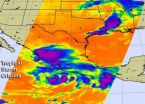(Press-News.org) ANN ARBOR–Childhood lead exposure costs Michigan residents an estimated $330 million annually, and a statewide remediation program to eliminate the source of most lead poisoning would pay for itself in three years, according to a new report.
"Economic Impacts of Lead Exposure and Remediation in Michigan," compares the cost of four well-documented impacts of lead exposure--increased health care, increased crime, increase in special education, and decline in lifetime earnings--with the cost of lead abatement of high-risk homes.
The report is a collaboration between the University of Michigan Risk Science Center in the School of Public Health and the Michigan Network for Children's Environmental Health.
With 70 percent of lead exposure associated with lead-based paint, the researchers estimate that it would require an investment of $600 million to remediate the 100,000 high-risk housing units in Michigan–-an outlay that would pay for itself after three years when compared with the ongoing costs associated with exposure.
"This scenario suggests that each dollar invested in abatement would return approximately $2.80 in net cost savings over 10 years, $6.60 after 20 years, and after three decades the returns will increase tenfold to $10.50, and these benefits would continue for many years to come," said Tracy Swinburn, research specialist at the U-M Risk Science Center and author of the report. "These substantial economic returns are all in addition to improved health outcomes for thousands of Michigan children whose lead exposure could be avoided."
Of the four impacts of lead exposure considered in the report, decreases in lifetime earnings due to lead-associated IQ loss are the most costly, with an estimated annual loss of $206 million. Costs associated with increases in crime, health care and special education are $105 million, $18 million, $2.5 million, respectively.
"It is well-documented that childhood lead exposure is associated with a wide range of irreversible and costly health effects and behavioral problems. However, this is the first time these impacts of lead exposure have been compared with the costs of abatement in Michigan," Swinburn said.
The report focuses on a cohort of Michigan's 1-2 year olds who are identified as "children who should be tested" by the Michigan Department of Community Health Statewide Testing Plan. Using already published data, the authors estimate that close to 70,000 Michigan children are considered at high risk of lead exposure as their blood lead levels exceed the 5 micrograms per deciliter 'action level' set by the Centers for Disease Control and Prevention.
The research team included Tracey Easthope and Rebecca Meuninck from the Michigan Network for Children's Environmental Health.
"This study illustrates that increasing support for lead remediation in the state is a wise investment in Michigan's children and economy," said Rebecca Meuninck, campaign director for the Michigan Network for Children's Environmental Health. "This economic analysis adds another layer of evidence to the already well-documented public health justifications for lead abatement. We hope the study will bolster the ongoing conversations about the impact of childhood lead exposure in Michigan, the real opportunities for prevention, and help place this issue in the context with other economic and health priorities."
INFORMATION:
The "Economic Impact of Lead Exposure in Michigan" is a follow-up to "The Price of Pollution," a study published by the Ecology Center and Michigan Network for Children's Environmental Health in 2010.
More information
Economic Impact of Lead Exposure in Michigan (PDF): http://www.riskscience.umich.edu/wp-content/uploads/2013/12/Economic-Impact-of-Lead-in-Michigan-Web.pdf
The University of Michigan Risk Science Center: http://www.riskscience.umich.edu
Michigan Network for Children's Environmental Health: http://www.mnceh.org
The Price of Pollution: http://www.mnceh.org/sites/http://www.mnceh.org/files/mnceh/documents/The%20Price%20of%20Pollution.pdf
Early Childhood Lead Exposure and Academic Achievement: Evidence From Detroit Public Schools, 2008, http://ajph.aphapublications.org/doi/pdf/10.2105/AJPH.2012.301164
Lead poisoning and asthma among low-income and African American children in Saginaw, Michigan http://www.sciencedirect.com/science/article/pii/S0013935110001908
Lead abatement a wise economic, public health investment
2014-06-10
ELSE PRESS RELEASES FROM THIS DATE:
The whole truth
2014-06-10
CAMBRIDGE, MA -- Children learn a great deal about the world from their own exploration, but they also rely on what adults tell them. Studies have shown that children can figure out when someone is lying to them, but cognitive scientists from MIT recently tackled a subtler question: Can children tell when adults are telling them the truth, but not the whole truth?
Led by Laura Schulz, the Class of 1943 Career Development Associate Professor of Cognitive Science, the researchers found that not only can children make this distinction, but they can also compensate for incomplete ...
Wolves in wolves' clothing not all the same
2014-06-10
New research co-authored by University of Calgary alumna Erin Navid provides evidence that British Columbia's mainland wolves and coastal wolves are more distinct than previously believed.
The research, published today in the scientific journal BMC Ecology, affirms what Chester Starr, an elder from the Heiltsuk First Nation on BC's remote west coast, and his people have always known: 'Timber Wolves' occupy the mainland of the British Columbia coast and 'Coastal Wolves' live on the nearby islands. Starr's insight provided motivation for the study.
"What makes this study ...
Coho salmon: Pinks' and chums' eating cousin
2014-06-10
Newly published research co-authored by scientists at Simon Fraser University and the Raincoast Conservation Foundation shows juvenile coho salmon benefit from dining on the distant remains of their spawning pink and chum cousins.
While juvenile coho salmon feed directly on spawning pink and chum salmon carcasses and eggs, even coho with no direct contact with spawning pink and chum benefit from their nutrient contributions to stream ecosystems.
The new research shows that juvenile coho abundance is up to three times higher in streams with abundant pink and chum compared ...
Genetics reveal that reef corals and their algae live together but evolve independently
2014-06-10
New research reveals that Caribbean corals and the algae that inhabit them form a remarkably stable relationship -- new knowledge that can serve as an important tool in preserving and restoring vital reef-building corals. A scientific paper describing these new findings by a team of marine biologists at Penn State University will be published as a cover article in Molecular Ecology on 10 June 2014.
Coral reefs are important for protecting shorelines, providing seafood, and generating millions of dollars in recreation revenue each year, but rising water temperatures due ...
Miriam Hospital study shows how to make statewide health campaigns more effective
2014-06-10
PROVIDENCE, R.I. - Researchers from The Miriam Hospital have found that adding evidence-based weight loss strategies to a statewide wellness campaign improves weight loss outcomes among participants. The study and its findings are published online in advance of print in the American Journal of Public Health.
Lead researcher Tricia Leahey, Ph.D., and her colleagues chose to conduct a study among participants in Rhode Island's annual, three-month statewide health campaign. Called Shape Up Rhode Island (SURI), the campaign was founded in 2005 and takes a grass roots approach ...
NASA sees Tropical Storm Christina's birth and severe weather in US South
2014-06-10
NASA's Aqua satellite captured a picture of newborn Tropical Storm Cristina on June 10, marking the birth date of the Eastern Pacific Ocean's third tropical storm of the season. The same image showed the severe weather affecting the south central U.S.
Although not at the coastline, the National Hurricane Center said that Cristina is near enough to cause dangerous surf conditions.
According to the National Hurricane Center (NHC), swells generated by Cristina are affecting portions of the south-central coast of western Mexico. These swells will likely continue through ...
NASA-NOAA's Suomi NPP satellite spots Arabian Sea tropical cyclone
2014-06-10
Tropical Cyclone 02A formed in the Arabian Sea as NASA-NOAA's Suomi NPP satellite passed overhead and captured a visible photo of the storm, spotting strongest storms south of its center.
On June 10 at 08:21 UTC (4:21 a.m. EDT), when Suomi NPP passed over 02A, the Visible Infrared Imaging Radiometer Suite (VIIRS) instrument aboard captured a visible image of the storm. VIIRS collects visible and infrared imagery and global observations of land, atmosphere, cryosphere and oceans.
In the image, Tropical Storm 02A appeared slightly elongated but satellite data shows that ...
NASA's SDO sees a summer solar flare
2014-06-10
The sun emitted a significant solar flare, peaking at 7:42 a.m. EDT on June 10, 2014. NASA's Solar Dynamics Observatory – which typically observes the entire sun 24 hours a day -- captured images of the flare.
Solar flares are powerful bursts of radiation. Harmful radiation from a flare cannot pass through Earth's atmosphere to physically affect humans on the ground. However, when intense enough, they can disturb the atmosphere in the layer where GPS and communications signals travel.
To see how this event may affect Earth, please visit NOAA's Space Weather Prediction ...
Inside the adult ADHD brain
2014-06-10
CAMBRIDGE, MA -- About 11 percent of school-age children in the United States have been diagnosed with attention deficit hyperactivity disorder (ADHD). While many of these children eventually "outgrow" the disorder, some carry their difficulties into adulthood: About 10 million American adults are currently diagnosed with ADHD.
In the first study to compare patterns of brain activity in adults who recovered from childhood ADHD and those who did not, MIT neuroscientists have discovered key differences in a brain communication network that is active when the brain is at ...
Mammography has led to fewer late-stage breast cancers, U-M study finds
2014-06-10
ANN ARBOR, Mich. — In the last 30 years, since mammography was introduced, late-stage breast cancer incidence has decreased by 37 percent, a new study from the University of Michigan Comprehensive Cancer Center finds.
The analysis takes into account an observed underlying trend of increased breast cancer incidence present since the 1940s, a sort of inflation rate for breast cancer.
Researchers looked at early-stage and late-stage breast cancer diagnoses between 1977-1979, before mammography became popular, and compared it to diagnoses between 2007-2009. Based on trends ...





